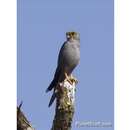Biology
provided by Arkive
The diet of the grey kestrel consists of insects, such as grasshoppers, flying termites and ants, as well as small reptiles, rodents, birds, bats and even earthworms. It may also eat oil palm fruits, one of only three raptor species known to do so. Hunting is usually undertaken from a high, open perch, with the kestrel taking prey from the ground or from low foliage, though it may also chase birds and insects in flight (2) (4) (5). Nesting usually occurs between January and April in West Africa, and between August and October in Kenya, Tanzania and Angola (2), the breeding pair often taking over Hamerkop (Scopus umbretta) nests, even evicting the residents, or using tree cavities or old stick nests (2) (4) (5). Two to five eggs are laid, hatching after an incubation period of between 26 and 31 days. Fledging occurs after approximately 30 days (2) (4).
Conservation
provided by Arkive
The grey kestrel is listed on Appendix II of the Convention on International Trade in Endangered Species (CITES), meaning that international trade in grey kestrels should be carefully monitored and controlled (3). However, there are no other known conservation measures currently in place for this species.
Description
provided by Arkive
The grey kestrel is a fairly small and stocky bird of prey with, as its common name suggests, entirely slate grey plumage, which contrasts strongly with its bright yellow eye ring, cere, legs and feet. The head is large, with a heavy black beak and brown eyes, the wings are fairly short and pointed, and the ends of the primary flight feathers are blackish (2) (4) (5). Potentially confused with the sooty falcon, Falco concolor, the grey kestrel is more heavily built, with shorter wings, which do not reach the end of the tail when the bird is perched (4) (6). Male and female grey kestrels are similar in appearance, but males are about three-quarters the size of the female, while juveniles can be distinguished by the brown wash to the plumage, the paler abdomen, and pale green facial skin (2) (4) (6). The grey kestrel flies with fast, shallow wing beats, interspersed with short glides, usually low over open ground or among trees, but hovering is not commonly seen. The call is a shrill keek-keek-keek, given at the nest, and sometimes a whistling scream (4) (5).
Habitat
provided by Arkive
The grey kestrel inhabits woodland, wooded grassland and savanna, including palm savanna, often near clearings and burnt areas, where it regularly hunts (2) (4) (5). It can be found at elevations of up to 1,800 metres (4).
Range
provided by Arkive
Most of sub-Saharan Africa, from Senegal east to Ethiopia and Eritrea, and as far south as Namibia, Zambia and Malawi (2) (4) (7). The grey kestrel is mostly sedentary, but may make some seasonal movements in parts of West Africa (4).
Status
provided by Arkive
Classified as Least Concern (LC) on the IUCN Red List (1) and listed on Appendix II of CITES (3).
Threats
provided by Arkive
The grey kestrel has a wide distribution and a large global population, and is not currently considered at risk of extinction (7). Grey kestrels are thought to readily adapt to human land-use, often hunting on agricultural land and possibly even benefitting from forest clearance (2) (4).

